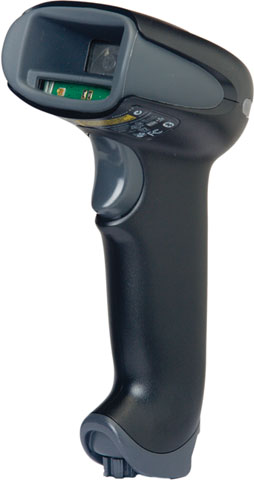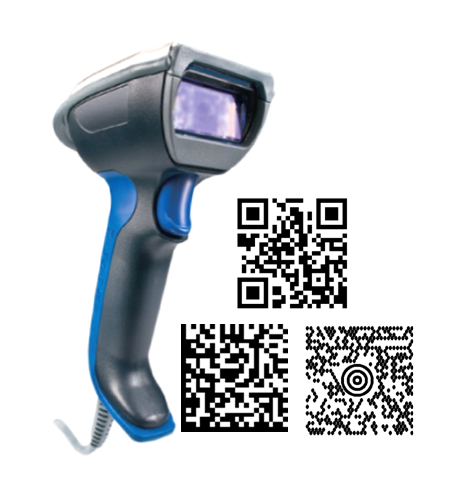Microscan Imagers Ensure 2D Code Readability and Increase Efficiency During Manufacturing of Miniature Identifiers
The Challenge
A leading supplier of electrical and fiber optic interconnects, switches and application tooling, manufactures miniature identifier chips that provide unique product traceability of work-in-progress (WIP) printed circuit boards (PCBs) in medium to high-volume electronics assembly processes.
The pad measures only 2.80mm by 1.80mm, and is just 0.30mm thick, requiring minimal space on a PCB. Each pad is laser etched with data using a Data Matrix 2D code that provides explicit identification for 1 billion unique combinations. This is particularly important for customers that have multiple surface-mount technology (SMT) lines or multiple contract manufacturers. Every single board remains unique, providing traceability to the production equipment and/or supplier used for a particular board. It also results in very significant cost savings as all of the infrastructure required is already in place on the customers’ SMT lines.
New Expanded Functionality for the Honeywell Xenon Scanners

The Honeywell Xenon series are already some of the most aggressive and capable full 2D imagers on the market today and they continue to get better! With the new firmware update for the Xenon 1900 and the cordless 1902, a host of enhancements have been added to these scanners including additional functionally and improved bar code reading.
The new firmware update includes:
Decoder improvements – Improved reading on Data Matrix bar codes with the ability to decode Data Matrix ECC 0, 50, 80, 100, and 140. Mirrored Data Matrix codes are also now automatically handled by the scanner.
ColorFusion Image Processing Capability – New support for processing images with a variety of image filters for all Xenon 1900/1902 Color and Color-Capable models. Filters include: Infinity filter, Compensation, Pixel depth, Edge sharpen, Histogram stretch, Inverse filter, Noise reduction, Image rotate, JPEG image quality, Gamma correction, Image cropping ,Pixel skip, Document image filter, Blur image, and Histogram ship.
IBM Support – New enable/disable commands specified by IBM to USB and RS-485 to enable/disable: GS1, GS1 expanded, GS1 composites, PDF, MaxiCode, OCR, Data Matrix, Aztec, QR, and code 49.
Cordless enhancements – A new batch mode option to retain data until the user sends or scans a clear command.
Data formatting updates – Added ability to insert a string and to send data up to, but not including, a string.
All new Xenon scanners will be shipping with the new firmware but updating your current unit is a simple download. You can add all the new features in just a few minutes. For more information on the Xenon series or the new firmware update feel free to contact us at Barcodes Inc.
Honeywell’s New Area-Imaging Scanner the Voyager 1400g
Honeywell’s new upgrade-able imaging scanner provides the best of all worlds to businesses looking to implement 2D bar codes.
2D bar codes are becoming increasingly popular across a wide range of industries for a number of reasons. Some enterprises have a desire to capture large amounts of data, despite space constraints, while others are being required to read 2D bar codes due to government regulations or supplier mandates. Also, an even larger group of enterprises simply have the desire to leverage emerging trends, today or in the future, without purchasing additional scanning hardware. Built on the platform of Honeywell’s world-renowned Voyager series of linear scanners, the Voyager 1400g delivers omnidirectional linear bar code reading, plus the ability to affordably upgrade the device to enable 2D bar code scanning as scanning needs evolve.
The Voyager 1400g will soon be available and you can contact us for more details and ordering.
The Next Generation Warehouse : Long Range Scanning and the Emergence of 2D Barcodes
Introduction
Today’s warehouses are rapidly evolving as they seek to keep up with a variety of new requirements and advancements in technology. Processes traditionally using 1-dimensional bar codes are becoming more accurate, more efficient, and more robust through the transition to 2D symbologies. Offering superior data storage capability yet compact in size, these 2D symbols are ideal for cradle-to-grave tracking of products and serialization. As imaging technology progresses, businesses are poised to take advantage of the benefits of implementing 2D while continuing to accommodate the long range scanning requirements typical in the warehouse environment.
Driving this transition is the growing need to track individual parts from assembly to shipment and beyond for information and traceability purposes, largely imposed by company-specific or legislative requirements. A 2D bar code can accommodate significantly more information than its 1d counterpart, and in a fraction of the space, making such traceability possible.
Historically, laser scanners have been the preferred technology in warehousing because of their speed, accuracy, and ability to read at long range. however, as 2D bar codes become more common and imaging technology matures, manufacturers are now discovering what imagers have to offer in terms of flexibility, traceability, and legislative standards compliance.
Imaging Moves Into the Mainstream
 Why 2D Imagers are Surpassing Laser Scanners for Bar Code Applications
Why 2D Imagers are Surpassing Laser Scanners for Bar Code Applications
Misperceptions about 2D imagers are changing fast, which is why 2D imagers are the fastest-growing category of bar code readers. Only a few years ago 2D imagers were (wrongly) considered a niche technology mostly used for reading 2D bar codes. Now they are becoming the technology of choice for most bar code applications, and lasers are on the way to becoming a niche technology. The reasons: 2D imagers are as fast or faster than laser scanners, can read all the same bar codes as lasers plus 2D symbols that lasers can’t, and can do much more.
Not only can 2D imagers read more bar codes than lasers – including QR Codes, Data Matrix and other popular 2D symbols – they can also do more than read bar codes. Imagers can take digital pictures, shoot video, capture customer signatures, scan documents and even process the scanned data. These capabilities, which are outlined in the graphic below, enable new business processes that are not possible with older-generation technology. In an era where workers are tasked with doing more – collecting more information, providing more documentation, being more productive, etc. – 2D imagers provide more flexibility.
2D imaging technology gives businesses the two things they need most from their bar code readers: outstanding performance in today’s applications, and investment protection to meet future needs. This white paper is a guide to 2D bar code imaging technology, including an overview of capabilities and how 2D imagers perform in traditional applications, the beneficial new business processes that imaging enables, and the advantages 2D imaging provides compared to laser scanners.




